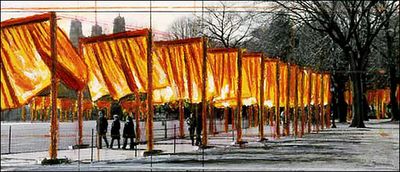Friday, February 11, 2005

With 45 television cameras in front of him and a view of bright orange vinyl gates stretching through Central Park behind him, Mayor Michael R. Bloomberg said yesterday that the city expected an infusion of $80 million in tourism and other spending by people flocking to see "The Gates," the vast public art project by the artists Christo and Jeanne-Claude. Worldwide interest in the project was clear at the news conference at the Metropolitan Museum of Art, where journalists from more than 200 media outlets, including networks in Sweden, Mexico City and Tokyo and others as unusual as Bulgarian national television, crowded into the Temple of Dendur to hear the mayor and the two artists discuss the project, whose saffron-colored fabric panels will be unfurled this morning. For Mr. Bloomberg - who has reduced the city's arts budget amid general cutbacks but has also emerged as the strongest promoter of public art at City Hall in decades - the event was a chance to bask in the glow of a near-perfect blockbuster project: one that comes at no cost to the city (the artists are paying for everything, including extra police officers) and that will attract thousands of art pilgrims to New York during a month when tourism is traditionally at its lowest. "With no ticket sales of any kind it's impossible to predict exactly how big an impact 'The Gates' will have during its 16-day stay here," Mr. Bloomberg said, "but based on attendance at similar events and other factors, the city's Economic Development Corporation estimates that the project will generate more than $80 million in economic activity for our city." The $20 million project was originally conceived by the artists in 1979 and was rejected by three mayoral administrations before Mr. Bloomberg's, in part because of concerns about its cost and about damage to the park. The mayor, who first became interested in the notion of "The Gates" in 1995 as a trustee of the Central Park Conservancy, made light of the project's long history yesterday, saying that it took Michelangelo four years to paint the ceiling of the Sistine Chapel and Beethoven five years to write the Ninth Symphony. "Mere blinks of an eye," he said, "compared to the time that it took to build the masterpiece that we are celebrating today." "I can't promise," he added, "particularly since this is New York, that every single person will love 'The Gates,' but I guarantee that they will all talk about it." "And that's really what innovative, provocative art is supposed to do," he added, as Jeanne-Claude and Christo sat next to him. Vince Davenport, the project's engineer, said that teams of workers would be standing by in case any of the 16-foot-high gates broke or were pushed down, and that a gate could be replaced in less than an hour. But both he and Raymond W. Kelly, the police commissioner, said they did not anticipate many problems, from either vandals or the weather. Mr. Davenport said that teams would begin manually unfurling the fabric at 8:30 a.m. and that all of the panels should be released by about 11. Asked often yesterday to explain the meaning of the project, Christo and Jeanne-Claude emphasized that its meaning would have to be found by those who walked through the 7,500 gates, spread over 23 miles of walkways. "It has no purpose," Jeanne-Claude said. "It is not a symbol. It is not a message. It is only a work of art." But Christo explained that it related in some ways to the unrealized plans of Frederick Law Olmsted and Calvert Vaux, the park's designers, to place iron gates at many of the entrances to the park. He added that the fabric panels, which will blow and curve in the wind, are also meant to remind viewers of the park's serpentine paths and the curves of the empty branches of the trees above them. After answering several questions, however, Christo became clearly frustrated by trying to explain his work and emphatically urged experience over rational inquiry. "This project is not involved with talk," he said. "It is real physical space. You need to spend time walking in the cold air - sunny day, rainy day, even snow. It is not necessary to talk." Copyright 2005 The New York Times Company
